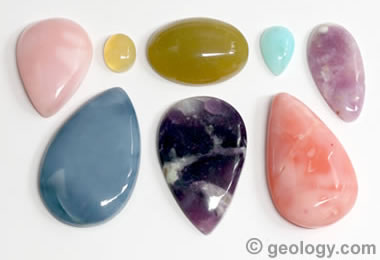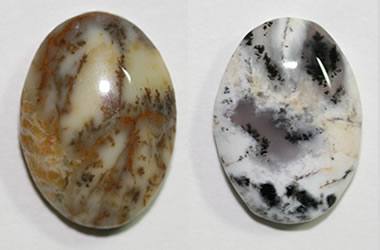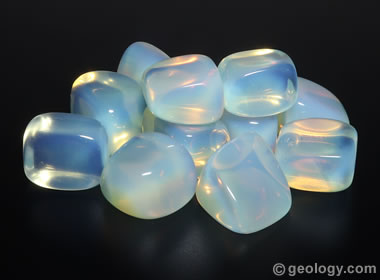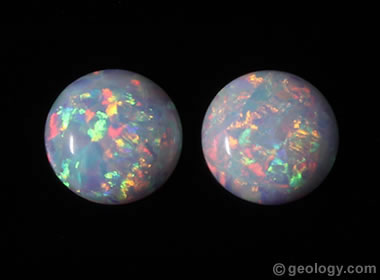
Natural Opalite: The word opalite was first used as a name for (natural) common opal (opal without play-of-color). The cabochons in the photo above are all natural common opal. They clearly demonstrate that common opal can be attractive enough to be used as a gem.
What is Opalite?
Opalite is a name used in two different ways:
1. As a synonym for common opal (natural opal that does not exhibit play-of-color).
2. As a marketing term used for numerous man-made materials that have an opal-like appearance but are composed of plastic or glass.

Natural Opalite: Most natural common opal is not as colorful as the gems in the top image; however, they can be cut into gems that many people enjoy. The above are examples of dendritic opal.
Natural Opalite
The name opalite was defined as common opal in geology and gemology glossaries as early as 1945. This predates the use of the word opalite as a marketing term for an imitation opal. [1] [2] It is defined as a natural common opal that does not show play-of-color. (The first use of the word opalite as a marketing term for man-made materials occurred in the 1980s.)
Common opal is found in many locations throughout the world. Most of it is a white to yellow to brown material that is usually not considered for use as a gem. However, some specimens of natural common opal have a wonderful color, accept a bright polish, and can be cut into highly desirable gems (see the photo at the top of this page).
Play-of-color is not needed for common opal to be used as a gem material. Some transparent specimens of common opal have a color and clarity that makes them worthy of being cut into faceted gems. Please see our articles about common opal and fire opal for much more information and lots of photos.

Man-Made Opalite: The name opalite has also been used for man-made materials. The material above has an opalescent luster but does not exhibit play-of-color. It is often sold as "opalite" without any disclosure of its man-made origin.

Play-of-Color in Imitation Opal: Many different materials are sold as "opalite" - including some that are imitation opal with true play-of-color.
Man-Made Opalite
The name "opalite" is used for a wide variety of man-made materials. Many of them would be properly labeled "imitation opal" or "opal simulant" in a retail setting. They do not have the same chemical composition and physical properties as natural opal; instead, they simply look like natural opal.
Man-made materials called opalite range from glasses and plastics that have a pearly or opalescent luster, to plastic-impregnated resins that exhibit a true play-of-color.
Some play-of-color opalites are convincing opal simulants that can be difficult to distinguish from natural opal by eye or even with a microscope. However, their high resin content changes other properties of the material. They usually have a lower specific gravity than natural opal, a lower hardness, and a different refractive index.
An experienced gemologist or a gem identification laboratory can tell the difference between common opal, imitation opal, and synthetic opal (a man-made material that has the same chemical composition and physical properties as natural opal).
If you are paying a lot of money for an opal and you want to make sure that it is a natural opal - rather than a man-made material - it is a good idea to submit the gem to a reputable gem identification laboratory.
| Opalite Information |
|
[1] Dictionary of Gems and Gemology, Second Edition, by Robert Morrill Shipley, Gemological Institute of America, 261 pages, 1945.
[2] Glossary of Geology, First Edition, American Geological Institute, 873 pages, 1972. [3] "Opalite": Plastic Imitation Opal With True Play-of-Color: by John I. Koivula and Robert C. Kammerling; article published in Gems & Gemology, Volume 25, Number 1, pages 30 to 34, Spring 1989. |
Disclosure at the Time of Sale
Man-made opal simulants can be legitimate products as long as they are not presented to buyers as natural opal. If the name "opal" is used, their man-made origin should be clearly revealed. This can be done with a preceding adjective, such as "imitation opal" or "simulated opal". Marketing them without disclosure could be considered as confusing, misleading, or fraud.
| More Gemstones |
 |
Tourmaline |
 |
Fancy Sapphires |
 |
Diamond |
 |
Canadian Diamond Mines |
 |
Birthstones |
 |
Pictures of Opal |
 |
Fire Agate |
 |
Blue Gemstones |

Find Other Topics on Geology.com:

|

| ||

|

| ||

|

| ||

|

|
